Over the 2019 J1 League season, Yokohama F. Marinos’ undisputed star man throughout the title-winning campaign was that of Teruhito Nakagawa. The 27-year-old right-winger was voted as the league’s Most Valued Player (MVP) for the season to cement his position as a key player.
With the Japanese forward having bagged a stellar 15 goals and 13 assists over 33 league appearances over 2019, Teruhito Nakagawa was truly deserving of the MVP title. Marinos’ winger is explosive and unpredictable, yet totally deadly. Nakagawa is almost the definition of a mercurial talent.
Despite his side suffering a shock 2-1 defeat to Gamba Osaka in the opening game of the 2020 J1 League season, this tactical analysis will dissect the key strengths of the 27-year-old forward. The scout report will then use analysis to explain how Nakagawa adds value to the tactics of Ange Postecoglu’s side.
Explosive dribbling
Any winger that is worth their salt must have a decent amount of close control and dribbling ability and Nakagawa has ample of both. The Japanese winger’s dribbling is somewhat comparable to that of the great Lionel Messi in that he is fast and agile yet keeps the ball close at his feet and always under control when dribbling. He is able to move at high speeds while always remaining just out of reach of any tracking defender when possible due to having the ball always at his feet.
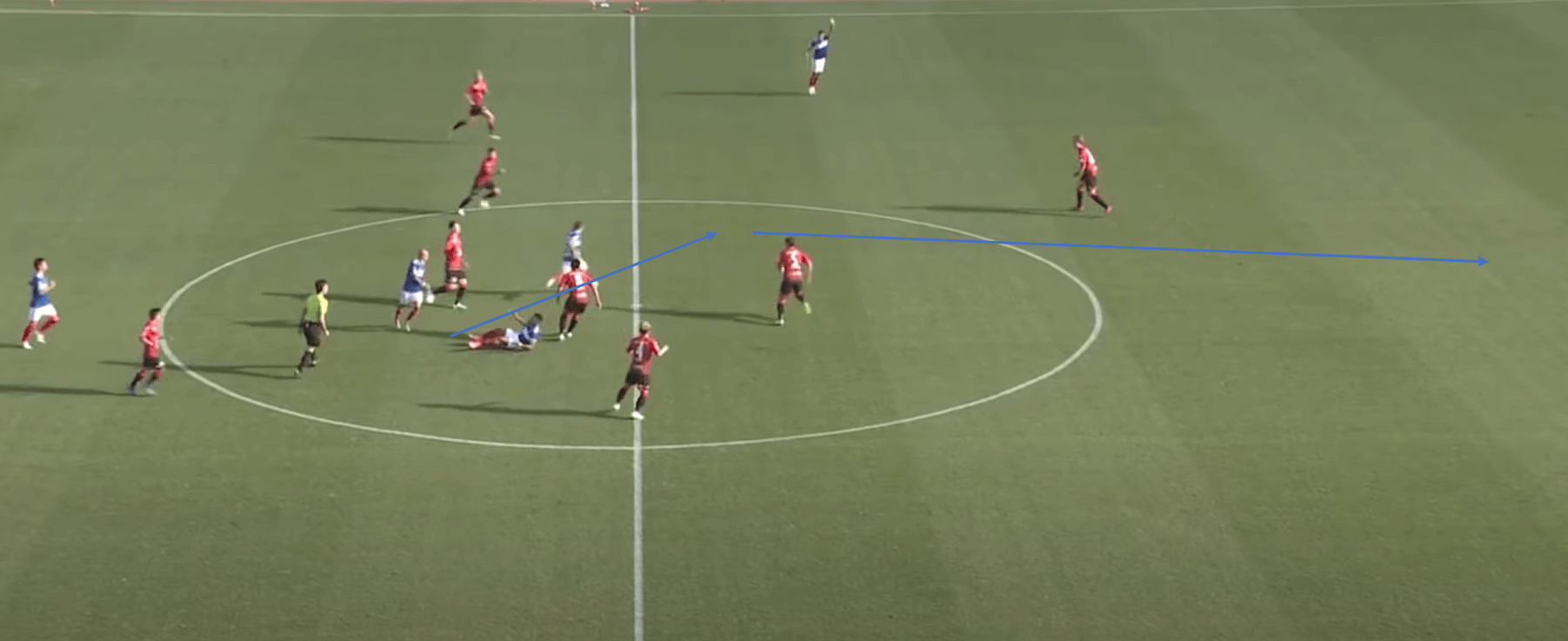
Here, during the 4-2 victory over Hokkaido Consadole Sapporo last season, an example of Nakagawa’s impressive dribbling ability can be seen. Having picked the ball up in the middle of the half of the centre circle in Marinos’ half, the Japanese winger has already dribbled through two defending players. The 27-year-old is then able to dribble out of the reach of the defender in the opposition’s half nearest the camera before a quick change of direction keeps him out of reach of the second defender.

Now, later in the same phase of play, Nakagawa has put himself in shooting distance while remaining out of the reach of any of the defending players. He has moved from his half with the ball without having been challenged due to his quick turn of pace. Despite having only the goalkeeper to beat, the right-winger retains his composure and dribbles out of reach of the ‘keeper, thus giving himself an open goal to finish into.
This dribbling ability offers Postecolgu a whole host of tactical avenues to use the winger in and the Yokohama side often rely on Nakagawa’s dribbling abilities when attacking down the right-hand side as the 27-year-old usually occupies the right-sided attacker’s spot in Marinos’ 4-2-3-1.
The route of Nakagawa’s goal threat
While Nakagawa has the habit of popping up in the opposition’s box in the right place at the right time to score his goals, his main threat comes from his ability to drive down the right-hand side of the pitch before quickly shifting onto his stronger left foot and curling a shot beyond the goalkeeper. The ability of the Japanese winger is perhaps comparable to that of Riyad Mahrez of Manchester City.
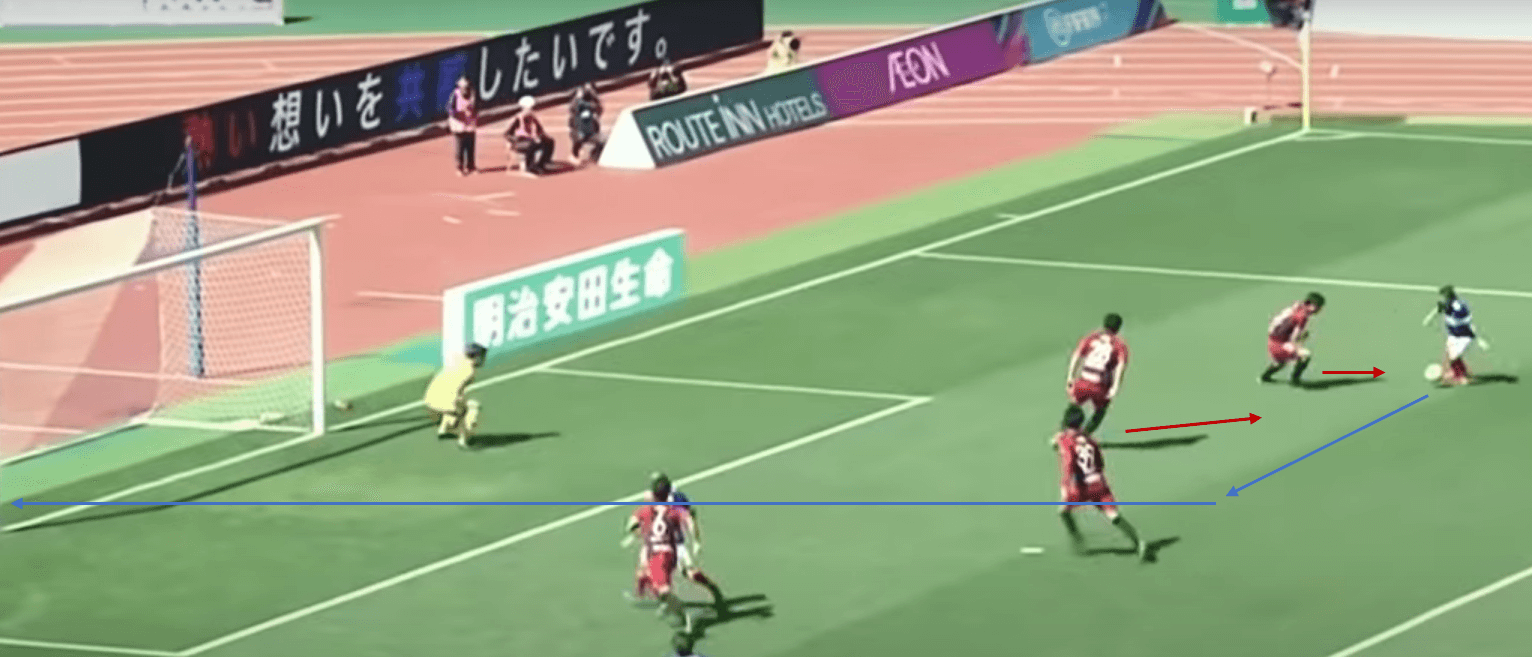
As can be seen here from last season, the right-winger has the ball down the right-hand side of the pitch with two defending players closing in on the ball to make a challenge. However, the 27-year-old is able to quickly change the ball from his right to his left foot, make enough space to fire a shot away and then execute the finish perfectly into the bottom corner of the net.
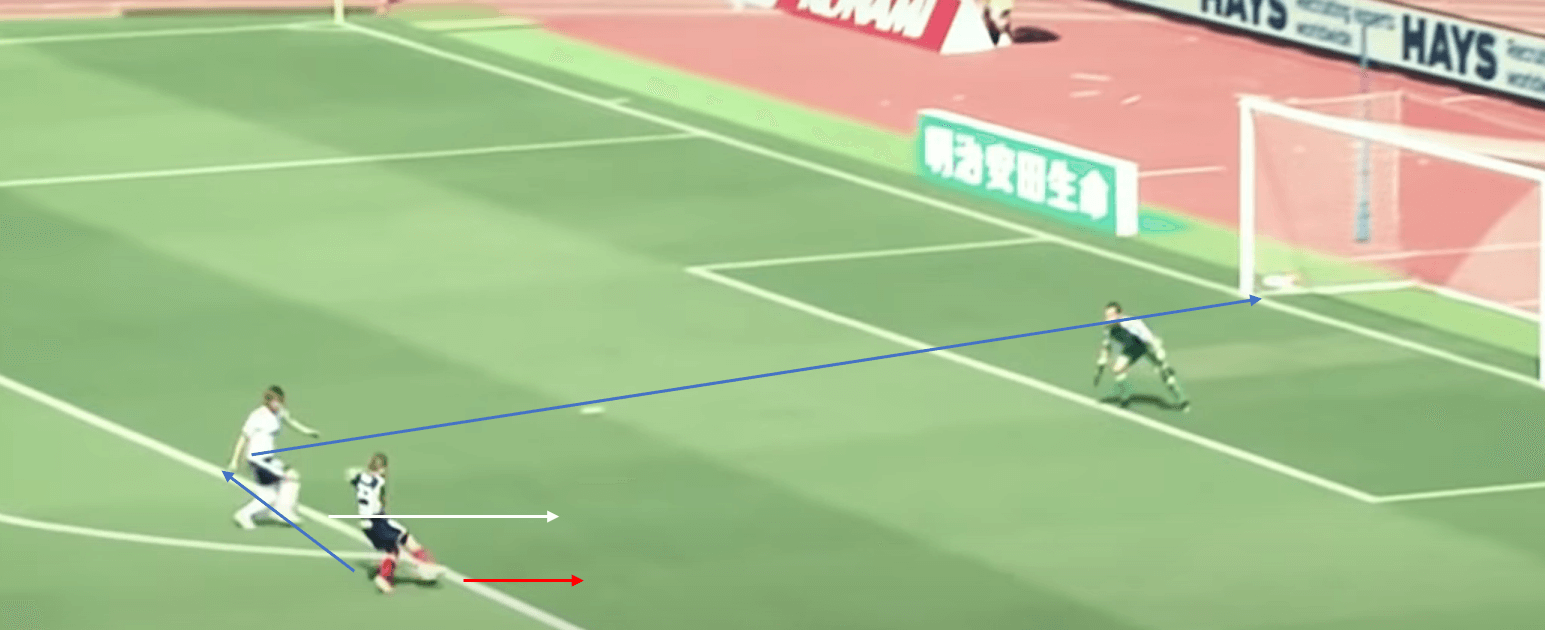
As can be seen here in another clip from last season, the Japanese winger again shows the speed of his ability to switch the ball from his right side to his left. Having gone one on one with the defender and with a clear shot at goal, Nakagawa feints his run – as marked by the red arrow – which sends the defender following the white arrow. That gives the right-winger time to switch the ball to his left foot and curl an exquisite finish into the bottom corner.
Again, this provides Postecoglu with a deadly potency to his attack and allows the manager to use inverted wingers in his 4-2-3-1 formation, which Marinos do. Having bagged an impressive 15 goals in 33 league appearances last season, it is clear that the speed of his attack and ability to shift from his right to his left at pace gives Nakagawa a strong attacking edge.
The route of Nakagawa’s assisting threat
If the Japanese right-winger solely relied on his ability to pick up the ball on the right-hand side and drift onto his left by driving infield, it may become predictable and eventually easy for defenders to stop, however, the route of Nakagawa’s assisting threat prevents the attacker from becoming predictable. Defenders who have done their homework on the winger ultimately give him space to avoid the 27-year-old cutting inside, however, this allows Nakagawa the space to fire in his effective drilled crosses.
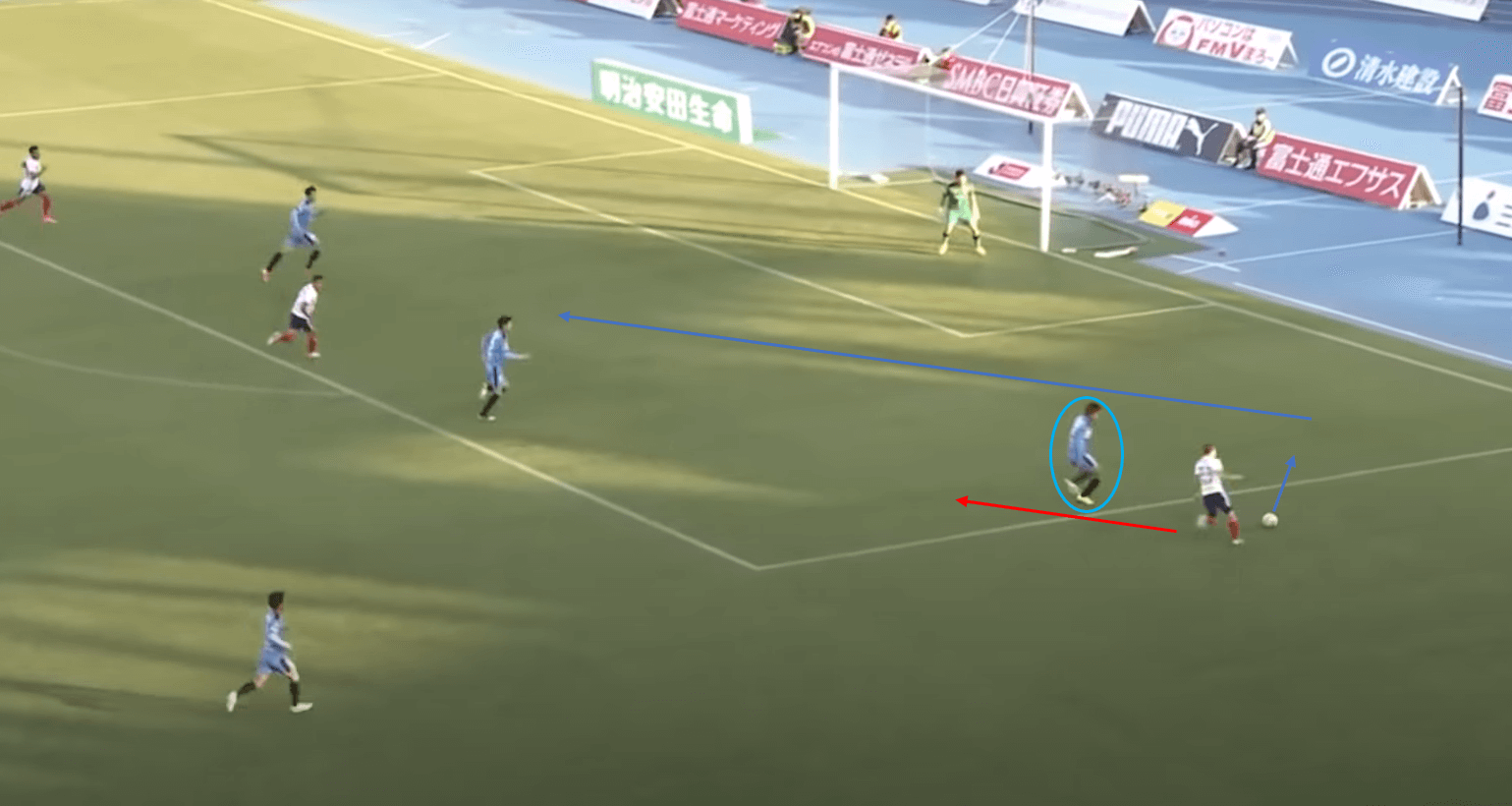
As can be seen here against Kawasaki Frontale during the 2019 season, the left-back has given Nakagawa plenty of space to avoid the winger making the run inside as marked by the red arrow. However, this then gives the 27-year-old the space to get a little closer to the byline and due to the player being abled with both feet, he fires a low cross into the path of Erik Lima who simply applies the finish.
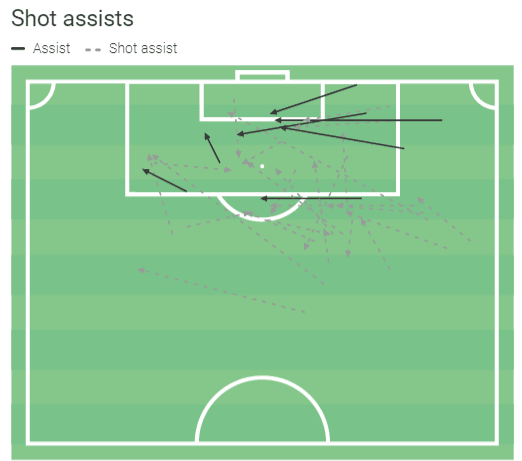
As can be seen on Nakagawa’s shot assist map from the last calendar year, the majority of his assists have come from crosses close to the byline in a similar area to where he was positioned in the previous annotation. It is this ability to cross accurately with his right foot, coupled with his deadly ability to drive infield with his left, which makes Nakagawa a handful to mark and defend against.
Inconsistent passing accuracy percentages
When diving into Nakagawa’s statistics a little deeper a weakness does arise, though. It becomes apparent that the right-winger can fluctuate between impressive passing accuracy percentages and under-par figures.
In the final game of the last calendar year against FC Tokyo, Nakagawa picked up a weak 69.4% passing accuracy, then, in the two AFC Champions League games at the start of this year, he recorded percentages of 88.5% and 90% before falling to 55% against Gamba Osaka. This pattern continues the further back through his statistics you go, having roughly two strong percentages followed by two much weaker ones.
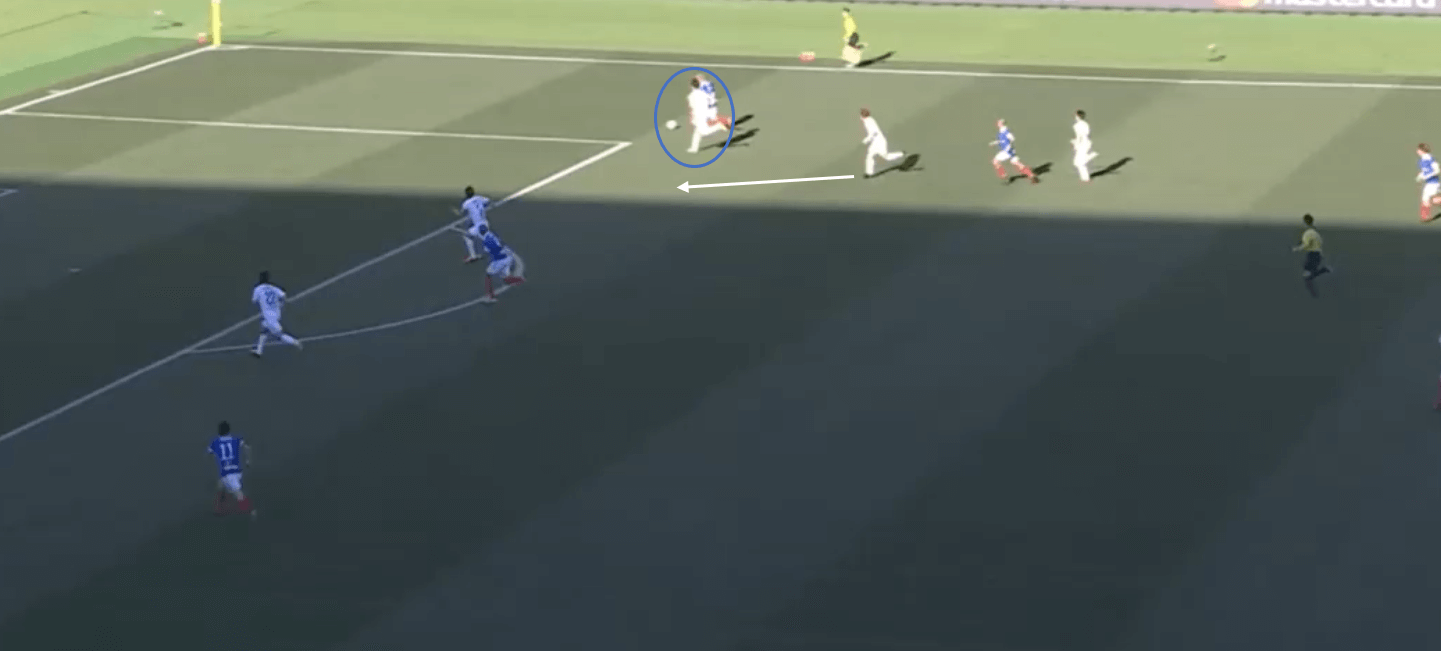
This annotation from the 2-1 defeat against Gamba Osaka at the beginning of the 2020 season could be an example of a reason why. In the opening game of the season, the right-winger struggled to have much influence on the tie and that may be because, where possible, Gamba Osaka doubled up on the 27-year-old.
As can be seen here, with the winger looking to get in behind, the full-back has gone tight to prevent Nakagawa having the space to drill a cross across the face of goal to a teammate. However, the wide midfielder has dropped deep to support the left-back to prevent the winger from having the space to cut in on his left – resulting in Nakagawa becoming isolated and struggling to be involved in the play.
So, this may suggest that some sides have the potential to marshal the winger out of the game if organised enough, meaning that Nakagawa and Postecoglu may have a potential flaw in how they play which should be worked on to bring the 27-year-old more into the game on occasion.
Conclusion
While a weakness may have arisen in this scout report which Nakagawa and Postecoglu could work on, it remains doubtless that the 27-year-old is one of the greatest talents that the J1 League has to offer and was ultimately fully deserving of the MVP title last season.
His three main attributes of his highly impressive dribbling, ability to cut inside and finish on his stronger left foot and accurately cross from the byline on his right make him unpredictable and difficult to defend against – which will likely be seen across the 2020 J1 League season.
Hopefully, for both Ange Postecoglu’s Yokohama F. Marinos side and the enjoyment of J1 League fans, the Japanese right-winger can recapture his stellar form of last season as an in-form Nakagawa is certainly a spectacle.
This tactical analysis has highlighted three of the key attributes and one weakness of Teruhito Nakagawa. The scout report has then used analysis to explain what tactical value the winger’s talents add to his side.





Comments